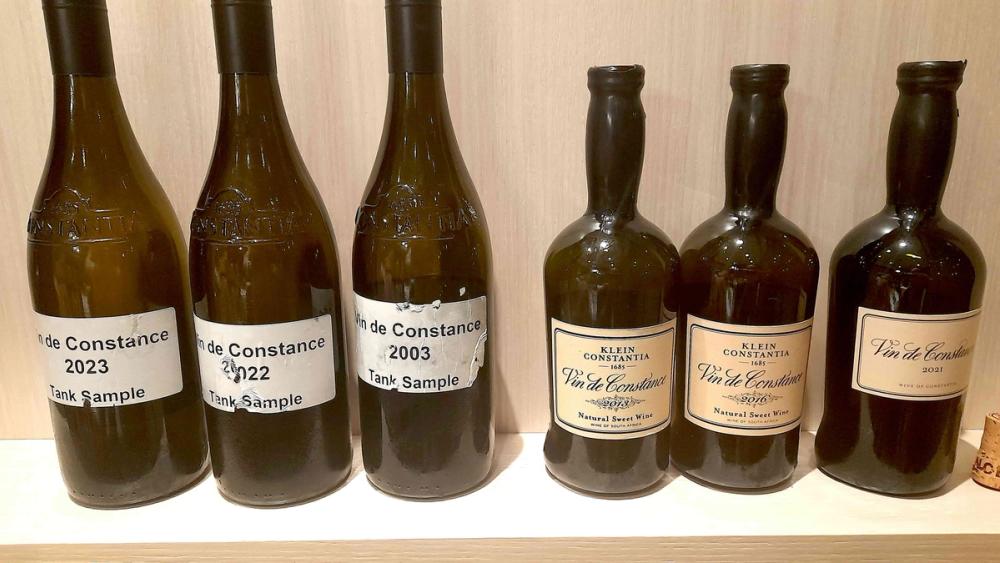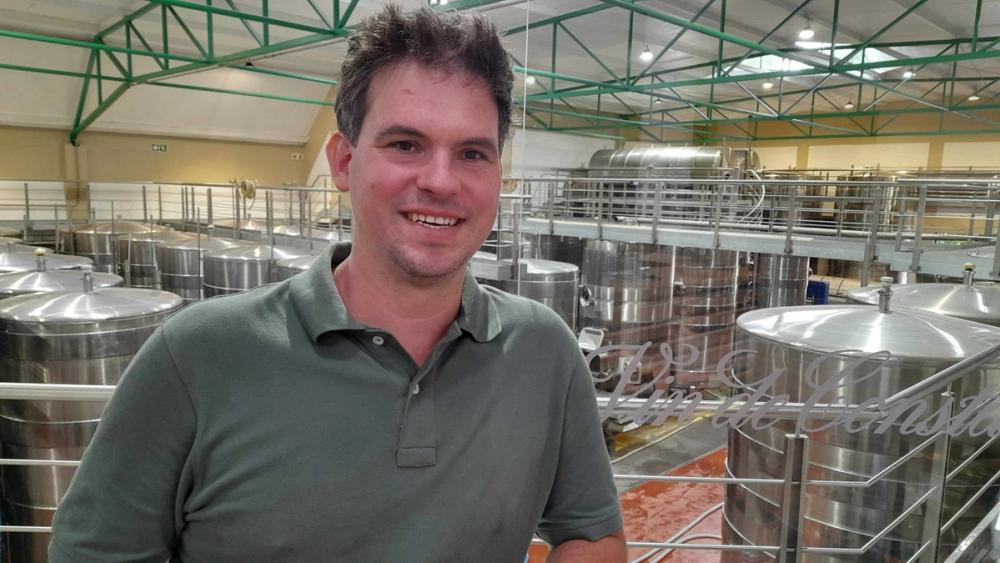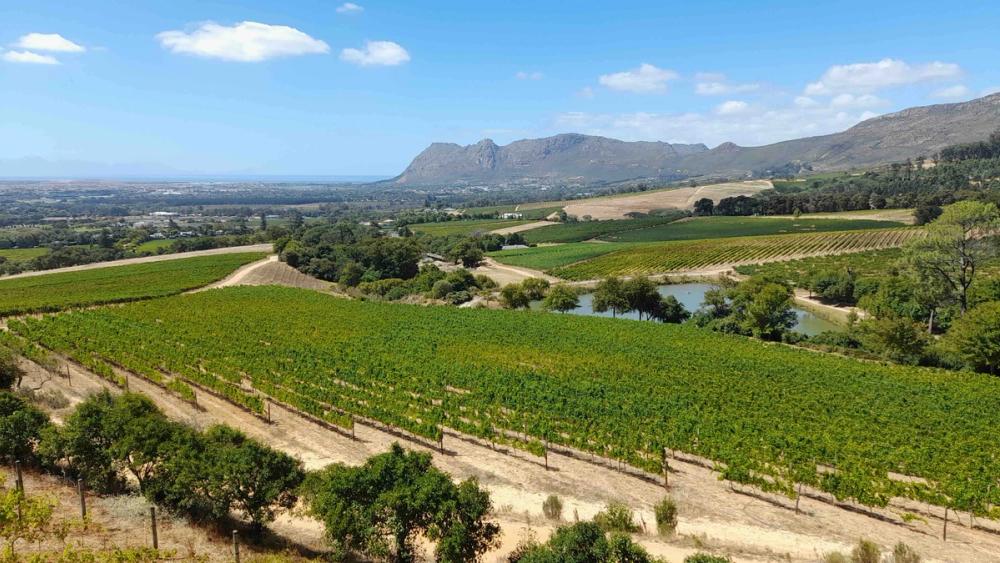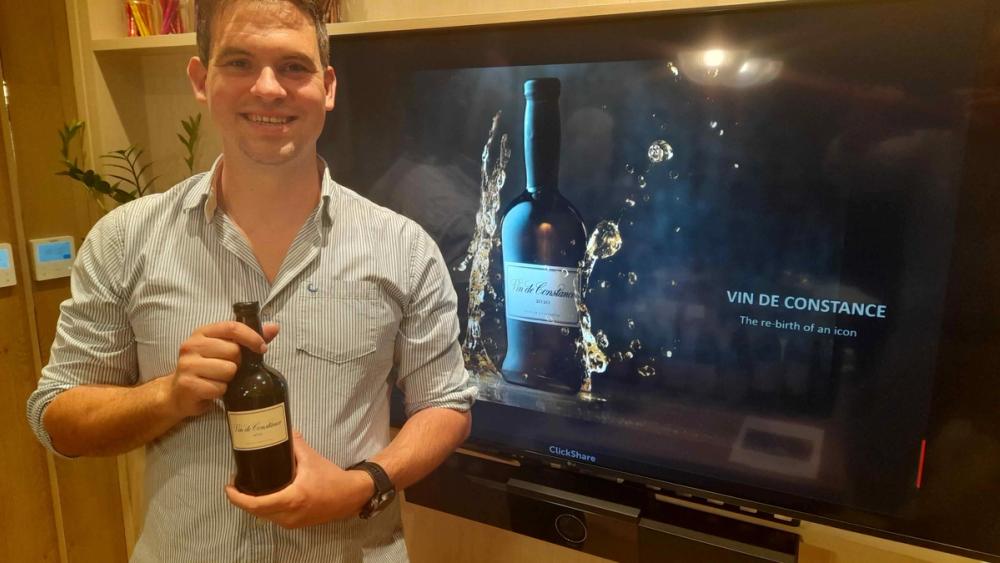Matt Day, the winemaker for South Africa’s greatest sweet wine, Vin de Constance, likes to challenge notions. For a start, despite its typical residual sugar levels of 155-170 g/l, he does not really think of it as a sweet wine.
“It tastes almost dry - that’s the key to Vin de Constance,” he mused, during a visit to London in mid-summer when he brought with him half a dozen different vintages, including samples of not just 2022 and 2023 but also 2003.

The latest release, the Vin de Constance 2021, is certainly beautifully delicate, as well as being charmingly refined.
“It’s not a sickly sweet wine - the residual sugar is there as a flavourant.,” Day added. “It’s all about the balance between sugar, alcohol and acidity. The goal is to figure out what that is and create a sweet wine that isn’t too sweet. The whole residual sugar discussion has got to the point where the level is so consistent, and that’s because of the blending during fermentation. You start with 25 batches, and you blend it, and you blend it again and you blend it again until you have a very homogenous kind of blend which has the right sugar, and right acid, and right amount of alcohol,” Day explains.
If 2021 is a favourite vintge of Day’s, he loves the 2016 no less. The latter is also the vintage to which Jancis Robinson has given her highest marks for those tasted in the last decade. Very intense, savoury and spicy, with dried pineapple notes, it was the first vintage to be made in a brand new cellar at Klein Constantia.

Matt Day in the winery: "242 is south-facing and only ten metres away from Block 241 but we’ll pick it six weeks later. That’s terroir."
“The tanks were specially designed for Vin de Constance,” Day revealed. “Ageing was in brand new foudres of 4,500 litres. It was a hot vintage with harvesting in three weeks of March when we made 23 passes. By contrast, we made 25 in 2021, when we finished in the first week of April. It was a weird year, but with fabulous flavour and concentration.”
The 2021 was the first vintage that saw elevage of 18 months in barrels (60% new) followed by another 18 months in the foudres that were installed in 2016. The purpose of the former is, Day says, to provide ‘a fast-track route’ from primary to secondary flavours though the influence of micro-oxygenation.
Primary flavours - aromatic fermentation characteristics such as lychee and Turkish delight notes - are attractively perfumed but ‘don’t taste a terrible lot’ in his words. “But I still want to create more complexity, so then it’s into foudres where it’s a time capsule, as it prevents any further oxidation, but you’re still getting integration of oak into the wine which becomes very interesting.”
The French influence on the estate’s Sauvignon Blanc

Klein Constantia has 42 blocks of outstanding Sauvignon Blanc
No less important to Klein Constantia than Vin de Constance are the estate’s 42 blocks of Sauvignon Blanc, which produce outstanding expressions of the varietal. The winery makes between 125-160,000 bottles of it each year, depending on yield, with several different small-production labels in addition to the estate Sauvignon, such as Metis, Clara and Perdeblokke. Rebranding, through new labelling and a new bottle shape, has been effected.
Day is not being immodest in declaring that “my goal as a winemaker is to make an iconic Sauvignon Blanc that is the New World reference of what Sauvignon Blanc is.” For Klein Constantia is blessed with perfect terroir, as acknowledged by one of Sancerre’s leading producers of Sauvignon.
“It was after I worked with Pascal Jolivet in Sancerre that I learnt that wine is made by terroir not the winemaker,” Day said. “His winemaker Jean-Luc Soty came to South Africa for the 2013 harvest with me, and said as we were walking through one of the blocks, ‘Matt this is perfect for my style of making wine: hyper-oxidised at crush, no settling, dirty fermentation on high soluble content, with wild yeasts and a long time on the lees.’”
“In those days we were making Sauvignon like we were taught at university - very clean, lots of sulphur, inoculated yeasts, cold fermentation, very short time on the lees, get it out of the cellar as quick as possible. But we made the Metis in his style, and learnt so much from that project that we started incorporating what worked in the Metis back into the estate Sauvignon Blanc. They were made in the same way, so we had to change the style of Metis quite a bit to differentiate it.”
This change in thinking did not end there.
“We started more of a micro-vinification approach,” Day continued. “We found the three best blocks with the grapes with the most personality, almost with salinity to them, and kept those separate for the Metis. Then the other big difference was we put it in neutral oak barrels and left it there for six to nine months depending on the vintage. It just created a different texture to the wine. The estate Sauvignon Blanc remained tank-fermented and tank-aged.”
Now every single one of the 42 Sauvignon blocks is made in its own tank, having its own personality and then being blended after six months on the lees. Then you have the perfect blending process, taking a bit from this tank and a bit from that one. Fortunately, I’ve been there for 16 years now, and understand the personality of the blocks.”
The French influence on Day has been profound.
“A lot of the blocks are made like Metis - high soluble content at fermentation, about 80% of it is hyper-oxidised at crush. When you’re hyper-oxidising, you’re doing everything you’re told not to with Sauvignon Blanc, but what we’re doing is oxidising away all those volatile thiols, getting rid of them before fermentation and creating a more solid textured structure when you go into the fermentation. You create a wine that is going to be robust and last for a very long time as opposed to Sauvignon Blanc that changes literally within six months of bottling and is terrible.”
The DNA of Klein Constantia
Klein Constantia’s terroir, or DNA as Day likes to call it, is worth detailing.
The blocks are east-facing and south-facing, with the former a lot warmer, receiving the morning sun. The latter are much colder, and benefit from higher acidity and freshness, with more pyrazines in terms of flavours. Then, there is both low and high altitude, with a range of 70m to 340m at the top. As you ascend, it gets exponentially colder due to the influence of the cold Atlantic Ocean.
“A great example of how that affects the harvest is that Block 241 is first to be picked, usually on February 1 - that’s at 200m on an east-facing slope,” Day revealed. “242 is south-facing and only ten metres away but we’ll pick it six weeks later. That’s terroir. The alcohol will be 13.8-14% abv for both, with pH the same. In Sancerre, harvest lasts 2-3 weeks only, but here it’s over 3 months.”
Two different types of geology are found at Klein Constantia: decomposed granite and Table Mountain sandstone.
“The sandstone is in the top-lying pocket, and affects the highest vineyards we have,” Day added, “and all the alluvial soil we have is sandstone eroded down. But the core of these two wines is granite. Sandstone brings out richness and texture, roundness to the mid-palate; granite brings out savoury, salty, umami characters. But with 42 blocks bringing all those contributing factors, you can have so much fun as a winemaker putting together a blend. You can have a little bit of that saltiness with the bright fruit, with the acidity, and you can create that perfect masterpiece, which is what we're trying to do.”
The Perdeblokke is what Day describes as “our rock star Sauvignon Blanc: single vineyard, barrel-fermented, barrel-aged, only five barrels of it. It has so many tiny little pockets of terroir….south-facing, east-facing and different altitudes from 70 to 340 metres. Very few vineyards in the world can have this different exposure to terroir.”
The reds of Anwilka
Finally, although white wines are his focus, Day is relishing the challenge of making the red wines of Anwilka, which is also owned by the proprietors of Klein Constantia. He took over at the Stellenbosch estate for the 2021 vintage when the winemaker there moved to Wales. Leafroll virus is a big issue, requiring constant replanting, but it is a premium location for Cabernet Sauvignon and Syrah.
“It’s been fun as I love Syrah and took inspiration from Gramercy in Washington State with its white pepper notes,” Day reflected. “There is a lot of koffieklip, well-drained gravel, sandy loam and some granite. It’s in the foothills of the Helderberg, so you’ve got the benefits of the heat of Stellenbosch but also the cooling effect of the ocean seven kilometres away. The goal is to be organic but not certified with sustainability the watchword. I have had the owners’ backing all the way, and it’s been a great journey with them.”
We tasted the Anwilka 2020 (76% Cabernet, 24% Syrah) which has very fine, well-integrated tannins. Day modestly credits Klein Constantia co-owner Hubert de Boüard, the well-known Bordeaux vigneron, for them.
“Hubert has attention to detail like none other when it comes to tannin extraction,” he said. “He’s a master from whom I’m still learning. The focus is to have a great red wine in our portfolio.” In managing that, Day is presiding over a notable triumvirate of world-class wines.
Tasting the new Klein Constantia and Anwilka vintages

Klein Constantia Estate Sauvignon Blanc 2022
Benchmark South African Sauvignon; grapefruit and lime on the nose, with seductive quince, orange zest and citrus blossom notes on the palate; refined, with delightful crisp freshness as well as texture from six months on the lees. (RSP £20)
Klein Constantia Sauvignon Blanc Clara 2021
Blackcurrant leaf herbaceousness with appealing note of nettliness. Fabulously intense with exceptional length. No new oak (compared to 50% new in both 2019 and 2020). One of the greatest vintages in the western Cape. A blend of the five best barrels from the best six vineyards. Racy acidity (pH 3.14) but in perfect balance (13.9% abv). (£31.50)
Klein Constantia Sauvignon Blanc Metis 2019
The flower pictured on the label is a hybrid of the South African protea and French iris to reflect the collaboration with Sancerre vigneron, Pascal Jolivet. Clear hints of salinity to accompany flinty minerality. Aromas of blackcurrant leaf, wet slate and lime give way to complex notes of kiwi fruit and lemon zest on the palate. Nine months on the lees gives texture and weight. Notably long finish to a wine that really sang. (£26)
Klein Constantia Sauvignon Blanc Perdeblokke 2021
High altitude block; very pronounced fruit intensity with pink grapefruit notes. Very perfumed and aromatic with great tension. Nine months on the lees. Really good oak integration (five barrels only made - none new, second, third or fourth fill). Very special wine from 24-year old vineyard. 14.3% abv but well-balanced thanks to thrilling acidity (pH 3.16). (£36)
Klein Constantia Estate Red 2020
69% Cabernet Sauvignon, 28% Malbec, 3% Petit Verdot. Deep ruby red in colour, aromas of strawberries and red peppercorns; red fruit on the palate with very silky tannins. Full-bodied with plenty of structure from 40% new oak. (£26.50)
Anwilka 2020
76% Cabernet Sauvignon, 24% Syrah. Refined, lighter style, yet complex and very concentrated black fruit with fine, well-integrated tannins. 18 months in 225-litre barrels (60% new). Syrah adds texture to backbone of Cabernet. A serious red wine with cellaring potential. (£35)
Anwilka Ugaba 2019
46% Syrah, 42% Cabernet Sauvignon, 8% Petit Verdot, 4% Malbec. Well-priced second label, named after the Xhosa word for ‘distinguished warriors.’ Attractive red cherry fruit predominates in this fresh, medium-bodied wine with soft tannins and a satisfying finish. (£20)
Vin de Constance 2021
100% Muscat de Frontignan,168 g/l RS. So delicate, so refined. Honeyed floral perfume and aromatic spices on the nose. Pickled ginger and jasmine notes stand out on the palate. Explosion of flavours on a magnificently long finish with a waxy coating layer, yet delightfully fresh till the end. Beautiful balance. (£60)
The wines of Klein Constantia are imported and sold in the UK through Mentzendorff which is a commercial partner of The Buyer. To discover more about them click here.
































